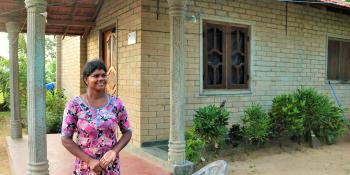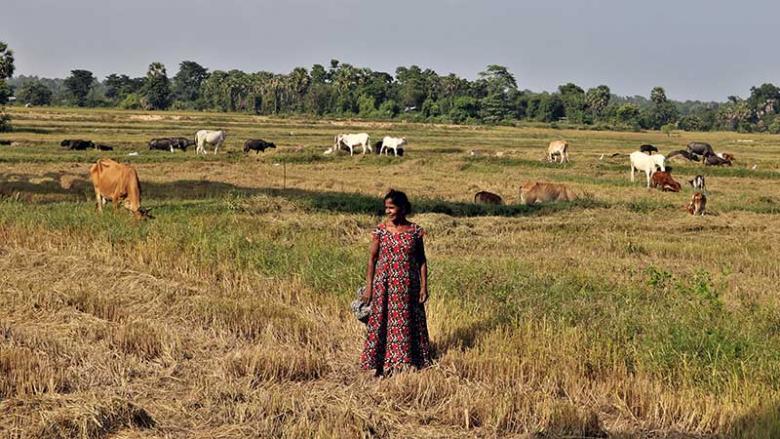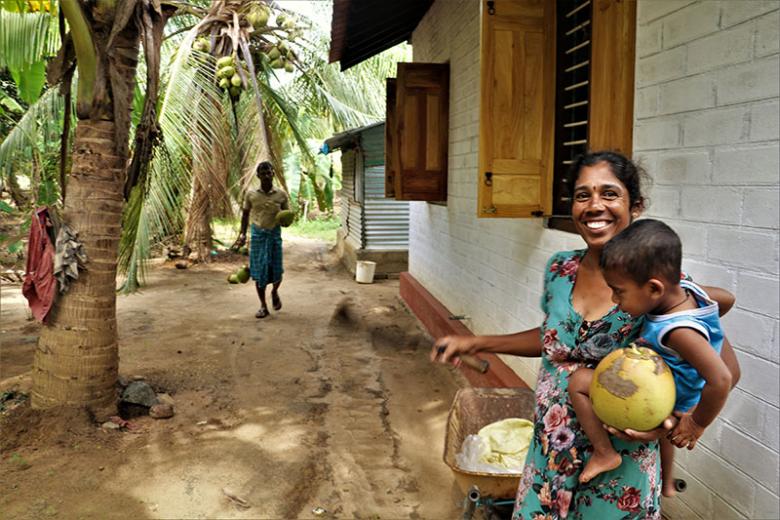Asia-Pacific Housing Forum
For more than a decade, the Asia-Pacific Housing Forum has gathered under one roof major stakeholders engaged in seeking solutions to affordable housing issues and promote decent housing as a driver of economic growth.
Habitat for Humanity report: Construction is vast source of jobs in emerging markets
Innovation Awards at the virtual Asia-Pacific Housing Forum to promote winning sustainable solutions for affordable housing
UN youth envoy to open volunteer conference supporting Habitat for Humanity’s COVID-19 response
Habitat for Humanity to hold Asia-Pacific Housing Forum in Thailand for the third time
Habitat’s regional ShelterTech accelerator concludes with bold vision for affordable housing sector
For my children's sake
Through the EU-funded “Homes not Houses” project, Sri Lankan families are building better lives.

Growing up during Sri Lanka’s decades-long civil war, Jeyanthini had to move from one refugee camp to another. The lack of stability took a toll on her education. She had to drop out from school in the eighth grade. “All I wanted was to make sure my children would get a sound education,” said Jeyanthini, 36. Since she has green fingers, she wished to have a big garden and a neat and safe home.
Jeyanthini fulfilled both her dreams by partnering with Habitat for Humanity Sri Lanka under the European Union-funded “Homes not Houses” project. She opted to build her house with eco-friendly compressed stabilized earth blocks or CSEBs after learning about the advantages of using such appropriate construction materials.
“We used to suffer in the scorching heat in our temporary shelter but this CSEB home is cool and comfortable. My youngest son sleeps in a hammock during the day without the fan,” she said.
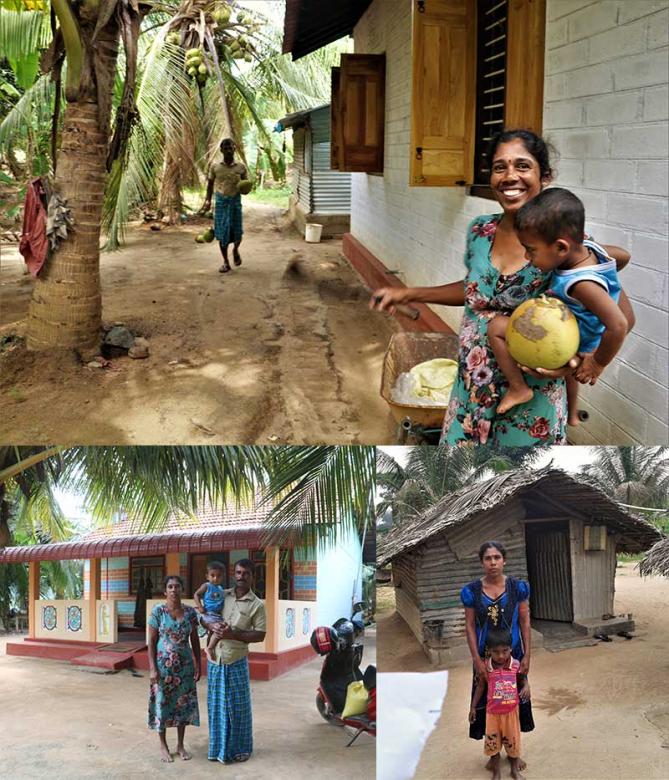
Jeyanthini, with her husband and younger son, showing the coconuts (top) from their farm, and outside their home (bottom left). They used to live in a temporary shelter (bottom right). Photos: Habitat for Humanity Sri Lanka/Jeevani Fernando.
In addition to building a safe home with a door that can be locked, Jeyanthini’s family received Habitat’s support in installing a water pump to irrigate their three-acre farm. Chillis, peanuts, coconuts and long beans are grown. “We harvest nearly 500 coconuts per week and can easily make about 30,000 Sri Lankan rupees (about US$150) in profit alone. Earlier, we could only depend on my husband’s income as a daily wage earner,” she said.
With enough savings, her family could paint the walls in the pastel colors that Jeyanthini likes. Her older son, Thevipuram, 4, is in primary school and is doing well in math and science. She would wait for him to come home from school in the afternoon while rocking Satheeshan, 1, to sleep. “Ever since we moved into this home in 2018, we have been blessed with good health and good income.”
As of June 14, 2021, a total of 2,370 returnee families have built or repaired their homes with Habitat Sri Lanka in the multi-year “Homes not Houses” project that began in January 2016. In addition, more than 46,000 people benefited from the project’s flanking measures implemented by Habitat’s partner World Vision Lanka. Such measures included disaster risk reduction mapping, establishment of small and medium-sized enterprises, and other capacity development activities. To improve communities’ resilience, culverts and roads were built, and flood water drainage systems were renovated.
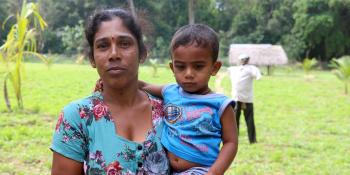
For my children's sake
Through the EU-funded “Homes not Houses” project, Sri Lankan families are building better lives.
Look how far we have come
Through the EU-funded “Homes not Houses” project completed in June 2021, Sri Lankan families like Nalini’s are building better lives.

For people like Nalini’s family who live off the land, the years of displacement during the decades-long civil war in Sri Lanka were particularly tough. “There were no shops nearby so everything had to be cultivated, grown and home-made. We lost all our assets during the war and my greatest worry was how to secure a good marriage for my daughter,” she said.
During the war-torn years, they had to contend with the demands of the Tamil Tiger rebels. In addition, they had to manage their relationship with the majority Sinhalese community in the North Central Province that bordered their village. The opportunity for change came in 2017 when Nalini and her family were among the first in Sinnawattai village to build homes with compressed stabilized earth blocks. Despite various challenges including access to the remote village, 39 families in Sinnawattai partnered with Habitat for Humanity Sri Lanka under the European Union-funded “Homes not Houses” project.
Nalini and her husband Sivaprakasam, both 64, still work in the paddy field and tend their cows and goats. Now they can earn about 15,000-20,000 Sri Lankan rupees (US$75-100) a month, double their income before they built their own home.
From the original pair of goats that Nalini’s family received as part of the project’s livelihood program, the herd has grown to 50. With the support of Habitat, the couple has fulfilled their goal of providing their only daughter Vadivalagi with a respectable dowry consisting of 50 goats and a brighter future.
“The house and the goats enabled us to provide for my daughter when she got married. She and her husband are now happily settled in with us,” Nalini said. “We only had a hut, and I still keep it behind our new home as a reminder of how far we have come. We have always made everything with our own hands, so building the house ourselves has brought me great satisfaction.”
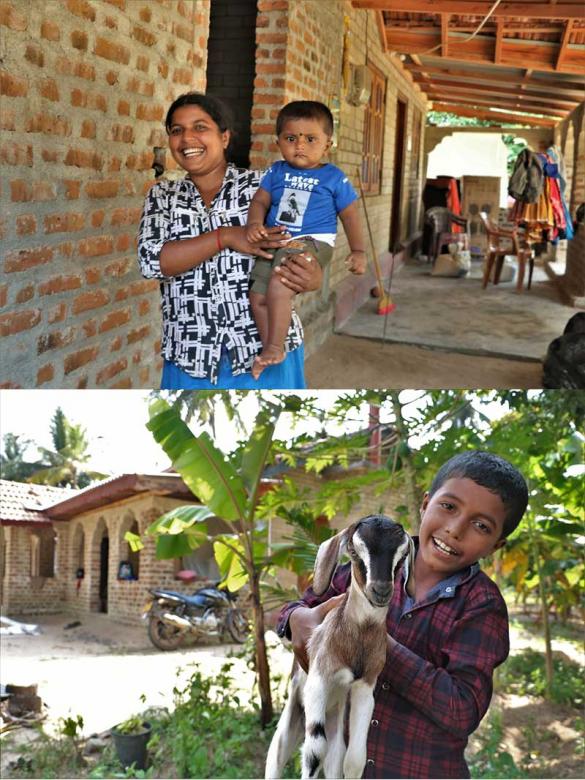
(Top) Vadivalagi with her younger son Thanushan outside their home;
(Bottom) her older son Theekshan with his kid friend. Photos: Habitat for Humanity Sri Lanka/Jeevani Fernando.
Beyond livelihood, Nalini’s grandson Theekshan, 8, is also pleased. His favorite pastime is to play in the paddy field with his four-legged friend, a kid named Kannukutty. Speaking of her grandson, Nalini said, “He is very lucky. He never has to be dragged from one refugee camp to another like I had to with my daughter. He has his own room now.”
In 2020, her family welcomed another grandson Thanushan. Living in a stable home, Nalini feels content and peaceful. She said, “My grandsons are now able to get an education. We get to spend time with them in our old age. I will never forget how things were and how things have changed for us as a family.”
As of June 14, 2021, a total of 2,370 returnee families have built or repaired their homes with Habitat Sri Lanka in the multi-year “Homes not Houses” project that began in January 2016. In addition, more than 46,000 people benefited from the project’s flanking measures implemented by Habitat’s partner World Vision Lanka. Such measures included disaster risk reduction mapping, establishment of small and medium-sized enterprises, and other capacity development activities. To improve communities’ resilience, culverts and roads were built, and flood water drainage systems were renovated.
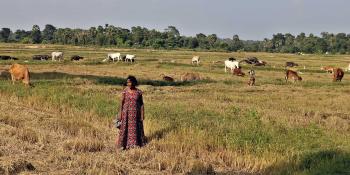
Look how far we have come
Through the EU-funded “Homes not Houses” project, Sri Lankan families are building better lives.
New chapter in life
Through the EU-funded “Homes not Houses” project completed in June 2021, Sri Lankan families are building better lives.

Over 12 years have passed since the civil war ended in Sri Lanka. Yet generations of families still bear the scars from the decades of violence and conflict. By building or repairing a place they can call their own, 2,370 families are starting a new chapter in life. They partnered with Habitat for Humanity Sri Lanka and World Vision Lanka under the European Union-funded “Homes not Houses” project completed in June 2021.
Thushanthini (main photo), 31, was raised by her aunt after her parents went missing during the 25-year civil war in Sri Lanka. To this day, she does not know what happened to her parents. Without any siblings or a home of her own, she was considered as among the most vulnerable in Navagirinagar village, Batticaloa, eastern Sri Lanka.
But she takes pride in a decision that she and her husband made in February 2018. “Ours was the first CSEB home in our tightly-knit community,” Thushanthini said. “Many of my neighbors came to visit us out of curiosity about this new material. Once they saw how versatile the bricks are and how nice they look even without plastering, the CSEBs became a popular selection for home construction.”
Her husband Mathivathanan is a mechanic and block-maker. In February 2018, he learned how to produce and build with CSEBs at the block yard run by World Vision Lanka in Batticaloa. Through a livelihood grant, he bought a hand-operated machine to produce the compressed stabilized blocks for the community as well as mold that he uses to produce bricks with decorative motifs. Almost one third of the 138 people trained in skills to produce and build with blocks were women. After being trained, 94 people were in block production yards with an average monthly income of 24,000-28,000 Sri Lankan rupees (about US$120-140).
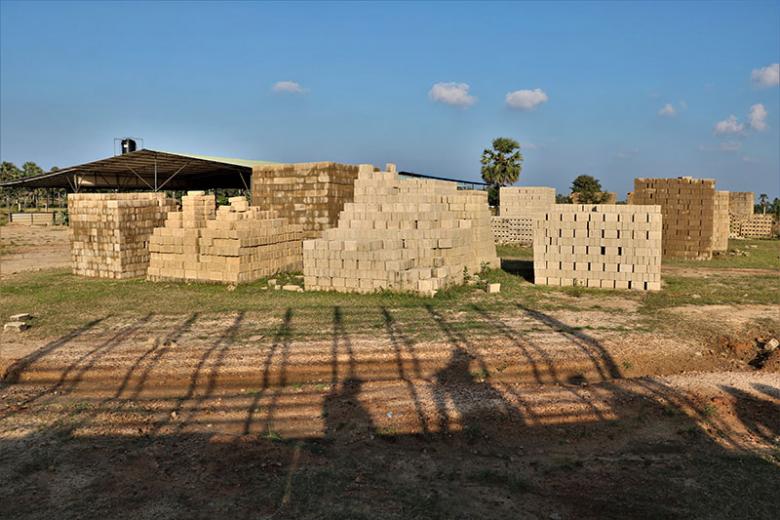
Thushanthini’s husband Mathivathanan was more than 130 people trained at the yard that produced compressed stabilized earth blocks in Batticaloa. Photos: Habitat for Humanity Sri Lanka/Jeevani Fernando.
The compressed stabilized earth blocks were among appropriate construction materials and technologies that were promoted in the “Homes not Houses” project implemented by Habitat for Humanity Sri Lanka and World Vision Lanka. Made of locally sourced materials, the energy-efficient blocks provided an alternative to mining sand and lowered the construction’s carbon footprint. The CSEBs are also known for the ability to keep a house cooler in hot weather and warmer when it is cold outside. In addition, a feasibility study published by the European Union cited CSEBs as a low-carbon, low embodied energy solution for sustainable development.
Based on a homeowner-driven approach, families managed their available resources using grants from Habitat Sri Lanka and built homes at their own pace with Habitat’s technical assistance to ensure construction quality. Although families had a choice of traditional construction materials like fired bricks and cement sand blocks, more than 1,000 of them or 45% of homeowners chose to build their homes with compressed stabilized earth blocks.
Stability starts with Home. These homeowners included Nalini and Jeyanthini who had experienced hardships during the war-torn years. Now that they have a place to call home, they can build their future on their own terms.
“We only had a hut, and I still keep it behind our new home as a reminder of how far we have come. We have always made everything with our own hands, so building the house ourselves has brought me great satisfaction.” — Nalini
“Ever since we moved into this home in 2018, we have been blessed with good health and good income.” — Jeyanthini
As of June 14, 2021, a total of 2,370 returnee families have built or repaired their homes with Habitat Sri Lanka in the multi-year “Homes not Houses” project that began in January 2016. In addition, more than 46,000 people benefited from the project’s flanking measures implemented by Habitat’s partner World Vision Lanka. Such measures included disaster risk reduction mapping, establishment of small and medium-sized enterprises, and other capacity development activities. To improve communities’ resilience, culverts and roads were built, and flood water drainage systems were renovated.

Flanking measures implemented under the “Homes not Houses” project included (from left) culverts, road drainage and a hazard maps.
Growing up without a decent home, Thushanthini has found stability in life. In the evening, she and her family often sit together on the veranda to watch the sun set. “This home,” she said, “is my most precious possession.”
